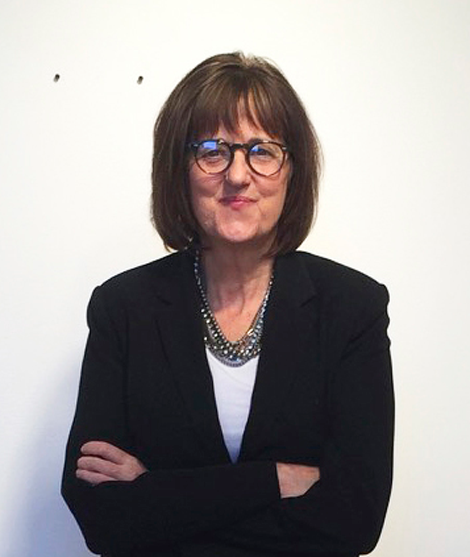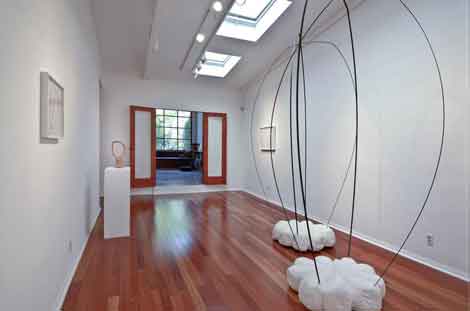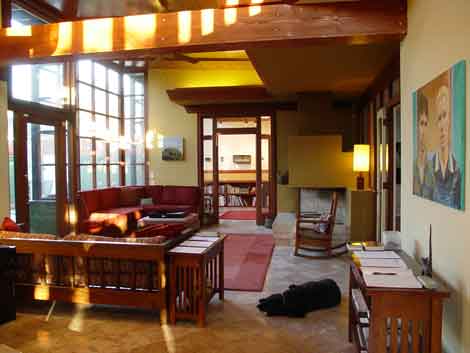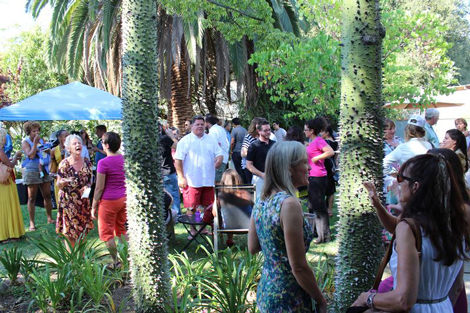Technically, a grande dame is a highly respected elderly or middle-aged woman who has extensive experience in her field. Although gallerist Jane Chafin is certainly not elderly, she is highly respected and experienced in our art business. And she is building a Gertrude Stein-like community here in the outlands of Pasadena through fine exhibitions and intriguingly diverse cultural events at her Offramp Gallery.
Offramp is located in Chafin’s home, a historic bungalow on the angled corner where an offramp of the 210 Freeway curves down to meet Lincoln Avenue. The structure has a second storey that hovers next to the elevated freeway and for years, the exterior walls of that storey held a Quinton Bemiller mural that echoed, in bright abstraction, the trees and hills beyond the gallery. Turning their heads only slightly, commuters could get a drive-by art experience. Today, the Bemiller landscape wraps around the large succulent garden on the north end of the bungalow’s backyard, just beyond the covered barbecue and dining area. Visitors who are initially taken aback by the idea of a gallery abutting a freeway are disabused of any negativity when they enter the welcoming tree-lined enclosure that is punctuated by sculpture (a remarkable piece in bright red by Jay Willis) and, almost always, familiar art world faces.
I arrived at Offramp Gallery to interview Chafin one sunny afternoon in October. She poured me some iced tea and invited me to join her on the wooden patio adjacent to the newly installed Bemiller. The conversation was easy and comfortable, like visiting an old friend.
The last thing I thought we’d discuss was the gallerist’s family history. But it turns out that Jane Chafin has a fascinating and unexpected backstory. Her paternal grandfather, Don Chafin, was sheriff of Logan County, West Virginia, from 1912 until 1924. He was so powerful that people called him “the boss” or “the czar.” The regional coalmine owners employed him to keep unions out of the county. Sheriff Chafin had his work cut out for him: Among the people agitating on behalf of the United Mine Workers union in West Virginia was Mary Harris Jones, later known as Mother Jones. As compensation for Sheriff Chafin’s efforts on their behalf, the mine owners reportedly bribed him over $50,000 a year (which was a lot of money in the 1920s!)
Sheriff Chafin’s conflict with the unions came to a head in the Battle of Blair Mountain, this country’s largest armed insurrection after the Civil War. In fall 1921, as a mob of angry miners threatened to march across Logan County, Chafin assembled an army of local volunteers. Violent conflict broke out and raged through the area until Federal troops came in to establish control. In the aftermath, Chafin was convicted of violations of the Volstead Act (National Prohibition Act) and imprisoned for two years. He left jail a notorious but wealthy man.
Jane Chafin’s West Virginia roots are not limited to her union-busting grandfather. She is also related to the Hatfield family of Hatfield-McCoy feud fame. In fact, Sheriff Chafin’s deputy—the man who, in the end, testified against the sheriff—was his cousin, Tennis Hatfield.
Sheriff Chafin’s youngest son, who went on to own and run Chafin Coal Company, was Jane’s father. When he died in 2006, he left Jane the money it took to purchase and remodel the old Pasadena home that is now Offramp Gallery.
Jane grew up interested in art but convinced she couldn’t do it. She remembers her mother repeatedly asserting, “I can’t draw a straight line and neither can you.” In college, the young Jane would lie on the library floor and look at art books. A roommate finally convinced her to take an art class to “get it out of her system.” It didn’t take Jane long to realize she was actually good at it. She began painting “surreal psycho-dramas” about her dreams and romantic relationships. She moved to Los Angeles in 1977 and began to exhibit her paintings, all the while thinking of herself as a rock musician. She took art classes at UCLA and Otis and was inspired by teachers like Jim Doolin, Jeffrey O’Connell, and Aron Goldberg. (She did an exhibition of Goldberg’s self-portraits at Offramp in 2009).
For a while, Jane financed her art practice by working at Licorice Pizza Records. Then in 1988, she got a job scheduling nude models for the drawing classes at the Los Angeles Municipal Art Gallery in Barnsdall Park. She stayed at Barnsdall for ten years, going from the job with the models to gallery attendant to the front office. Jane remembers feeling confused by some of the art exhibited at Barnsdall—she was, after all, a figurative artist working in the “heyday of conceptualism”—but she didn’t have the position or personal confidence to say or do anything about it.
Eventually, feeling deeply frustrated, she decided to try a new tack: In 1998, she moved to New York to be a writer. She worked for CultureFinder.com when it was trying to develop a national arts calendar. She moved up rapidly, becoming Managing Editor of the City Pages, then Editorial Director. Jane thinks of those years as “a wild ride.” As exciting as it was, the work burned her out. When her boss at CultureFinder moved to Patron Technology to launch PatronMail, Jane went with him and worked on the user interface. (Art organizations all over the country still use PatronMail for mass emails.)
In 2003, hardworking New Yorker Jane met architect Chaz Alexander on Match.com. They had two romantic years in New York, then Chaz took a job in Las Vegas, working on the design and construction of the Cosmopolitan Hotel. Jane found herself shuttling between New York where she continued to work, Las Vegas where Chaz lived, and West Virginia where her father was ill. After two years of hectic travel, Jane moved to Nevada to be with Chaz. The weather was “much nicer” than Manhattan and the couple lived in a spacious house with a swimming pool. Jane felt relaxed, like she was “on an extended vacation.” But Vegas culture didn’t appeal to Jane Chafin. She found herself at loose ends.
One Saturday night in 2007, she sat Chaz down and told him they needed to talk. She realized couldn’t stay in Las Vegas. Together, they decided to return to Southern California. The next morning, Jane got up to look at property in Pasadena. She perused the online real estate section of the Los Angeles Times and found the historic house that is now Offramp Gallery. She drove to Pasadena and invited photographer Anita Bunn to tour the 1924 bungalow with her. Right away, the two old friends realized the house had “huge potential.” Jane remembers walking in to the room that had once been a dance studio and saying to Anita, “This would make a great gallery.” It was the first time she’d considered running a commercial art space.
After her ten years at Barnsdall, Jane had mastered the mechanics of putting a show together. And she knew lots of artists. But the part she didn’t know—and it was, as she attests, “the crucial part”—was how to sell art. It’s a skill she’s still developing.
Jane went online and researched how to set up a business. The building needed cosmetic adjustments (they couldn’t leave the living room walls that dark purple) and some remodeling. Chaz oversaw the changes, as he continued working in Vegas through February 2008, then came to Los Angeles to work in a downtown firm. He later moved to a firm in Santa Monica, for which he oversaw the remodel of the Bel-Air Hotel. Chaz is now working with Jane at the gallery and consulting on strategic staffing issues with other architectural firms.
The gallery opened five years ago with “Anita Bunn: Blind Spot” (September 2008). Since then, there have been dozens of exhibitions: themed group shows; several one-person shows; exhibitions featuring young artists with little previous exposure; others showing current work by honored elders of California, such as the painting show by pioneer performance artist John M. White. There have also been myriad non-exhibition events, ranging from book readings, panel discussions, video screenings, and music performances, to wine-tastings and food events. Offramp attracts everyone from old collectors to young students, from long-time art world denizens to people who have not set foot in an art gallery before. And all of them return, again and again, creating a fluid community around the venue.
It’s not mystery why I felt that interviewing Jane Chafin was like visiting an old friend. The gallerist has the unique capacity to make people feel welcomed and valued. Part of this has to do with the fact that the gallery is located in her home. Part of it has to do with the many events held there and the diverse people whose creative efforts are being supported. But part of it—the almost ineffable part—has to do with the unique talents Chafin has, talents almost diametrically opposed to those of her outlaw sheriff grandfather who sought to keep people divided and disempowered. Jane Chafin is particularly skilled at bringing people together and building connections between them, at co-creating community with artists, art lovers, and those who haven’t though much about art—until they wonder into this unusual green house, just off the freeway, and see how cool it is.
The most recent Offramp Gallery exhibition (at the time of this writing) featured the “Urban Asia” photographs of publisher Kirk Pedersen, as well as artworks by each of the artists about whom Pedersen’s Zero+ Publishing has produced books. Pedersen has done books about Lisa Adams, Fatemeh Burnes, Lawrence Gipe, and Mark Whalen, among many others. The most recent Zero+ volume is on Mark Dean Veca, who recently completed a striking mural on a second storey wall of Offramp. Veca’s cartoony forms are dynamically arrayed across the surface like pop sardines in a densely packed tin. The contrast between Pedersen’s exquisite photographs and Veca’s anime-influenced painting gives an idea of the range of Jane Chafin’s aesthetic. She may not have felt comfortable commenting on some of the art at Barnsdall but at Offramp, she has created a place where she can say when she does and doesn’t like the art.
Jane told me that she’d recently read an article about the new metrics for success. The author urged readers to take money out of the equation. Instead, the author suggested, people should ask themselves if they are satisfied, if they are fulfilled, if they like what they’re doing. And she happily realized that although it’s true she’s not making a fortune with the gallery, she can definitely answer “YES!” to all three questions.
See more on Jane Chafin in our FIVE QUESTIONS new column.






